
Components of an electrical circuit are electrically connected if an electric current can run between them through an electrical conductor. An electrical connector is an electromechanical device used to create an electrical connection between parts of an electrical circuit, or between different electrical circuits, thereby joining them into a larger circuit. Most electrical connectors have a gender – i.e. the male component, called a plug, connects to the female component, or socket. The connection may be removable, require a tool for assembly and removal, or serve as a permanent electrical joint between two points. An adapter can be used to join dissimilar connectors.
A Controller Area Network is a robust vehicle bus standard designed to allow microcontrollers and devices to communicate with each other's applications without a host computer. It is a message-based protocol, designed originally for multiplex electrical wiring within automobiles to save on copper, but it can also be used in many other contexts. For each device, the data in a frame is transmitted serially but in such a way that if more than one device transmits at the same time, the highest priority device can continue while the others back off. Frames are received by all devices, including by the transmitting device.

A DC connector is an electrical connector for supplying direct current (DC) power.
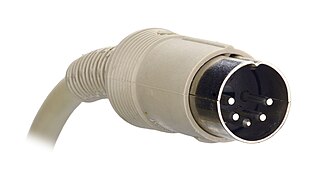
The DIN connector is an electrical connector that was originally standardized in the early 1970s by the Deutsches Institut für Normung (DIN), the German national standards organization. There are DIN standards for various different connectors.
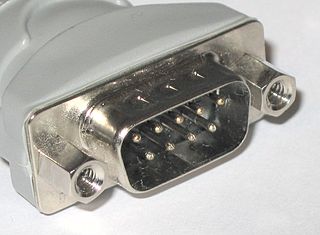
The D-subminiature or D-sub is a common type of electrical connector. They are named for their characteristic D-shaped metal shield. When they were introduced, D-subs were among the smallest connectors used on computer systems.

IEC 60309 is a series of international standards from the International Electrotechnical Commission (IEC) for "plugs, socket-outlets and couplers for industrial purposes". The maximum voltage allowed by the standard is 1000 V DC or AC; the maximum current, 800 A; and the maximum frequency, 500 Hz. The ambient temperature range is −25 °C to 40 °C.

On-board diagnostics (OBD) is an term referring to a vehicle's self-diagnostic and reporting capability. OBD systems give the vehicle owner or repair technician access to the status of the various vehicle sub-systems. The amount of diagnostic information available via OBD has varied widely since its introduction in the early 1980s versions of on-board vehicle computers. Early versions of OBD would simply illuminate a malfunction indicator light or "idiot light" if a problem was detected but would not provide any information as to the nature of the problem. Modern OBD implementations use a standardized digital communications port to provide real-time data in addition to a standardized series of diagnostic trouble codes, or DTCs, which allow a person to rapidly identify and remedy malfunctions within the vehicle.
![Chip tuning Modify memory chip in a car for better [https://www.x-performance.be// performance]](https://upload.wikimedia.org/wikipedia/commons/thumb/b/be/1995_Oldsmobile_88_Royal_control_chip_module.jpg/320px-1995_Oldsmobile_88_Royal_control_chip_module.jpg)
Chip tuning is changing or modifying an erasable programmable read only memory chip in an automobile's or other vehicle's electronic control unit to achieve superior performance, whether it be more power, cleaner emissions, or better fuel efficiency. Engine manufacturers generally use a conservative electronic control unit map to allow for individual engine variations as well as infrequent servicing and poor-quality fuel. Vehicles with a remapped electronic control unit may be more sensitive to fuel quality and service schedules.
OBD-II PIDs are codes used to request data from a vehicle, used as a diagnostic tool.

A modular connector is a type of electrical connector for cords and cables of electronic devices and appliances, such as in computer networking, telecommunication equipment, and audio headsets.

A coaxial power connector is an electrical power connector used for attaching extra-low voltage devices such as consumer electronics to external electricity. Also known as barrel connectors, concentric barrel connectors or tip connectors, these small cylindrical connectors come in an enormous variety of sizes.
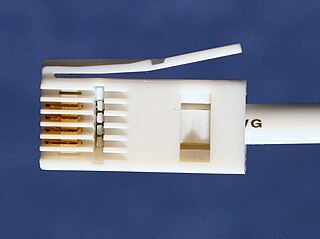
British telephone sockets were introduced in their current plug and socket form on 19 November 1981 by British Telecom to allow subscribers to connect their own telephones. The connectors are specified in British Standard BS 6312. Electrical characteristics of the telephone interface are specified by individual network operators, e.g. in British Telecom's SIN 351. Electrical characteristics required of British telephones used to be specified in BS 6305.
Assembly Line Diagnostic Link, Assembly Line Data Link, or ALDL is a proprietary on-board diagnostics system developed by General Motors before the standardization of OBD-2. It was previously called Assembly Line Communications Link or ALCL. The two terms are used interchangeably.
Audio connectors and video connectors are electrical or optical connectors for carrying audio or video signals. Audio interfaces or video interfaces define physical parameters and interpretation of signals. For digital audio and digital video, this can be thought of as defining the physical layer, data link layer, and most or all of the application layer. For analog audio and analog video these functions are all represented in a single signal specification like NTSC or the direct speaker-driving signal of analog audio.
OBDuino is an open source trip computer design based on the Arduino platform. An OBDuino may be assembled and customised by an electronics hobbyist; it displays information such as instantaneous fuel economy, engine tuning parameters etc. on an LCD.

IEC 62196Plugs, socket-outlets, vehicle connectors and vehicle inlets – Conductive charging of electric vehicles is a series of international standards that define requirements and tests for plugs, socket-outlets, vehicle connectors and vehicle inlets for conductive charging of electric vehicles and is maintained by the technical subcommittee SC 23H “Plugs, Socket-outlets and Couplers for industrial and similar applications, and for Electric Vehicles” of the International Electrotechnical Commission (IEC).

The Lucas 14CUX is an automotive electronic fuel injection system developed by Lucas Industries and fitted to the Rover V8 engine in Land Rover vehicles between 1990 and 1995. The system was also paired with the Rover V8 by a number of low-volume manufacturers such as TVR, Marcos, Ginetta, and Morgan.
An automotive scan tool (scanner) is an electronic tool used to interface with, diagnose and, sometimes, reprogram vehicle control modules.
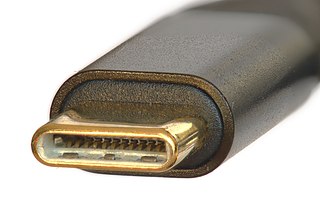
USB-C is a 24-pin USB connector system with a rotationally symmetrical connector. The designation C refers only to the connector's physical configuration or form factor and should not be confused with the connector's specific capabilities, which are designated by its transfer specifications.

The IEC 62196 Type 2 connector is used for charging electric cars, mainly within Europe. The connector is circular in shape, with a flattened top edge and originally specified for charging battery electric vehicles at 3–50 kilowatts, with a plug modified by Tesla capable of outputting 150 kilowatts. Electric power is provided as single-phase or three-phase alternating current (AC), or direct current (DC). In January 2013, the IEC 62196 Type 2 connector was selected by the European Commission as official charging plug within the European Union. It has since been adopted as the recommended connector in some countries outside of Europe, including New Zealand.
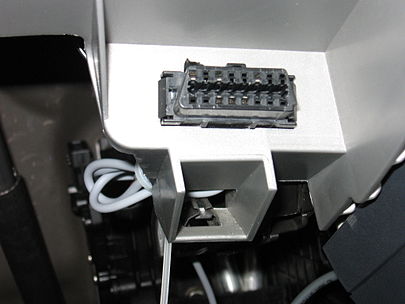








![Chip tuning Modify memory chip in a car for better [https://www.x-performance.be// performance]](https://upload.wikimedia.org/wikipedia/commons/thumb/b/be/1995_Oldsmobile_88_Royal_control_chip_module.jpg/320px-1995_Oldsmobile_88_Royal_control_chip_module.jpg)






